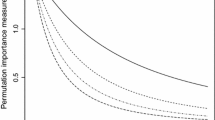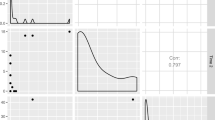Abstract
This paper presents an interpolation variance as an alternative to the measure of the reliability of ordinary kriging estimates. Contrary to the traditional kriging variance, the interpolation variance is data-values dependent, variogram dependent, and a measure of local accuracy. Natural phenomena are not homogeneous; therefore, local variability as expressed through data values must be recognized for a correct assessment of uncertainty. The interpolation variance is simply the weighted average of the squared differences between data values and the retained estimate. Ordinary kriging or simple kriging variances are the expected values of interpolation variances; therefore, these traditional homoscedastic estimation variances cannot properly measure local data dispersion. More precisely, the interpolation variance is an estimate of the local conditional variance, when the ordinary kriging weights are interpreted as conditional probabilities associated to the n neighboring data. This interpretation is valid if, and only if, all ordinary kriging weights are positive or constrained to be such. Extensive tests illustrate that the interpolation variance is a useful alternative to the traditional kriging variance.
Similar content being viewed by others
REFERENCES
Armstrong, M., 1994, Is research in mining geostats as dead as a dodo?: in Dimitrakopoulos, R., ed., Geostatistics for the next century: Kluwer Academic, Dordrecht, Netherlands, p. 303–312.
Deutsch, C. V., 1996, Correcting for negative weights in ordinary kriging: Computers & Geosciences, v. 22, no. 7, p. 765–773.
Deutsch, C. V., and Journel, A. G., 1992, GSLIB: Geostatistical software library and user's guide: Oxford University Press, New York, 340 p.
Diehl, P., and David, M., 1982, Classification of ore reserves/resources based on geostatistical methods: CIM Bulletin, v. 75, no. 838, p. 127–136.
Froidevaux, R., 1982, Geostatistics and ore reserve classification: CIM Bulletin, v. 75, no. 843, p. 77–83.
Froidevaux, R., 1993, Constrained kriging as an estimator of local distribution functions, in Capasso, V., Girone, G., and Posa, D., eds., Proceedings of the International Workshop on Statistics of Spatial Processes: Theory and Applications. Bari, Italy, p. 106–118.
Herzfeld, U. C., 1989, A note on programs performing kriging with nonnegative weights. Math. Geology, v. 21, no. 3, p. 391–393.
Isaaks, E. H., and Srivastava, R. M., 1989, An introduction to applied geostatistics: Oxford University Press, New York, 561 p.
Journel, A. G., and Huijbregts, C. J., 1978, Mining geostatistics: Academic Press, London, 600 p.
Journel, A. G., and Rao, S. E., 1996, Deriving conditional distributions from ordinary kriging: Stanford Center for Reservoir Forecasting (Report No. 9), Stanford, 25 p.
Journel, A. G., and Rossi, M. E., 1989, When do we need a trend model in kriging?: Math. Geology, v. 21, no. 7, p. 715–739.
Mood, A. M., Graybill, F. A., and Boes, D. C., 1974, Introduction to the theory of statistics (3rd edition): McGraw-Hill, New York, 564 p.
Olea, R. A., 1991, Geostatistical glossary and multilingual dictionary: Oxford University Press, New York, 175 p.
Wober, H. H., and Morgan, P. J., 1993, Classification of ore reserves based on geostatistical and economical parameters: CIM Bulletin, v. 86, no. 966, p. 73–76.
Yamamoto, J. K., 1989, A new method for ore reserve estimation and modeling: Brasil Mineral, v. 68, p. 52–56. (In Portuguese.)
Yamamoto, J. K., 1991, Comparison of computational methods for ore reserve estimation: A case study in the Chapada Copper Deposit, State of Goiás, Brazil: unpubl. Ph.D. thesis, University of São Paulo, 175 p. (In Portuguese.)
Author information
Authors and Affiliations
Rights and permissions
About this article
Cite this article
Yamamoto, J.K. An Alternative Measure of the Reliability of Ordinary Kriging Estimates. Mathematical Geology 32, 489–509 (2000). https://doi.org/10.1023/A:1007577916868
Issue Date:
DOI: https://doi.org/10.1023/A:1007577916868




